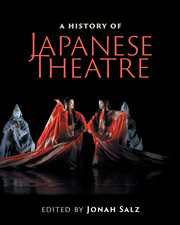Book contents
- Frontmatter
- Contents
- List of figures
- List of tables
- Contributors
- Contributors’ biographies
- Foreword
- Acknowledgments
- Note on Japanese terms
- List of abbreviations
- Timeline
- Editor's introduction
- I Traditional theatres
- Preface to Part I Japanese civilization arises
- II Modern theatres
- Preface to Part II
- 6 Birth of modern theatre: shimpa and shingeki
- Interlude Modern comedies and early musicals
- Interlude Takarazuka: all-girls’ revue and musicals
- 7 Rise of shingeki: Western-style theatre
- Interlude Manzai and Yoshimoto vaudeville comedy
- 8 Wartime colonial and traditional theatre
- Interlude Kami-shibai: picture-card storytelling
- 9 Maturing shingeki theatre
- Interlude Postwar musicals and commercial theatre
- 10 Sixties Theatre
- Interlude Butoh: dance of darkness and light
- 11 Contemporary theatre
- Interlude Tokyo: world theatre capital
- Interlude Charting Tokyo theatre today: 24 November 2012
- Interlude Modern theatre tomorrow: interview with Oriza Hirata
- III Arcs and patterns
- IV Theatre architecture
- Preface to Part IV Evolution of Japanese theatre architecture
- V Theatre criticism
- VI Intercultural influences
- Epilogue: Frozen words and mythology
- Further reading
- Index
- References
Interlude Postwar musicals and commercial theatre
from Preface to Part II
Published online by Cambridge University Press: 05 July 2016
- Frontmatter
- Contents
- List of figures
- List of tables
- Contributors
- Contributors’ biographies
- Foreword
- Acknowledgments
- Note on Japanese terms
- List of abbreviations
- Timeline
- Editor's introduction
- I Traditional theatres
- Preface to Part I Japanese civilization arises
- II Modern theatres
- Preface to Part II
- 6 Birth of modern theatre: shimpa and shingeki
- Interlude Modern comedies and early musicals
- Interlude Takarazuka: all-girls’ revue and musicals
- 7 Rise of shingeki: Western-style theatre
- Interlude Manzai and Yoshimoto vaudeville comedy
- 8 Wartime colonial and traditional theatre
- Interlude Kami-shibai: picture-card storytelling
- 9 Maturing shingeki theatre
- Interlude Postwar musicals and commercial theatre
- 10 Sixties Theatre
- Interlude Butoh: dance of darkness and light
- 11 Contemporary theatre
- Interlude Tokyo: world theatre capital
- Interlude Charting Tokyo theatre today: 24 November 2012
- Interlude Modern theatre tomorrow: interview with Oriza Hirata
- III Arcs and patterns
- IV Theatre architecture
- Preface to Part IV Evolution of Japanese theatre architecture
- V Theatre criticism
- VI Intercultural influences
- Epilogue: Frozen words and mythology
- Further reading
- Index
- References
Summary
Although Takarazuka and other groups had performed Western-style musicals and musical revues in prewar years, the musical truly emerged and developed in Japan during the Occupation, from 1945 to 1952, when Hata Toyokichi (1892–1956) began staging small-scale musicals. In 1955, Kikuta Kazuo (1908–73) initiated Tōhō Musicals, a series of popular, original performances. The entertainment conglomerate Tōhō, with divisions for film and stage production, quickly seized on Western-style musicals, having both the capital and the international connections to secure rights to perform foreign hits in Japan, in Japanese, with Japanese casts. Tōhō produced My Fair Lady in 1963 at the Tokyo Takarazuka, Japan's first all-Japanese cast musical: proof that Japanese audiences could accept an all-Japanese cast in a musical set in a foreign land.
Within the decade, Tōhō had seven theatres for staging Western-style musicals and large-scale straight plays. Its flagship 2,000-seat Teikoku Gekijō (Tokyo Imperial Theatre) was inaugurated in 1966 with Scaretto, a musical adaptation of Gone with the Wind. Tōhō productions of Fiddler on the Roof, starring Morishige Hisaya in 1967, and The King and I (1965) and Man of La Mancha (1969), both starring kabuki actor Matsumoto Kōshirō IX (1942–), rapidly followed. Tōhō could offer 500 performances annually of its various musical properties at the Imperial alone. Today Tōhō, which shares a repertory with Takarazuka, continues to stage traditional American musicals alongside international hits like the Austrian Elisabeth: The Musical, and original musicals such as Endless Shock (2000), about an off-Broadway success story, directed by boy-band producer Johnny Kitagawa (1933–), that has run over 1,000 performances nationwide in revised versions.
A troupe for all seasons: Gekidan Shiki
An entirely different trajectory was taken by the world's largest producer of musicals. Gekidan Shiki (Four Seasons Theatre Company, known as Shiki) was founded in 1953 by Asari Keita (1933–) as a shingeki company staging Western dramas in translation, including Chekhov, Anouilh, and Giraudoux. Inspired by the touring American production of West Side Story in 1964, however, Shiki began developing native triple-thread acting-singing-dancing talents, and mounting original musicals, such as The Emperor's New Clothes (1964). By the 1970s Shiki had grown into a massive company of over 1,000 members with nine home theatres in Tokyo, Nagoya, Osaka, Sapporo, and Fukuoka, which collectively staged over 3,000 performances a year, for an average of 800 per show of up to twelve concurrent productions.
- Type
- Chapter
- Information
- A History of Japanese Theatre , pp. 285 - 288Publisher: Cambridge University PressPrint publication year: 2016



